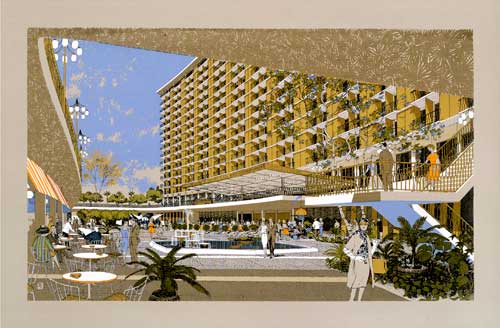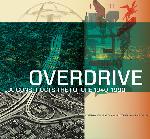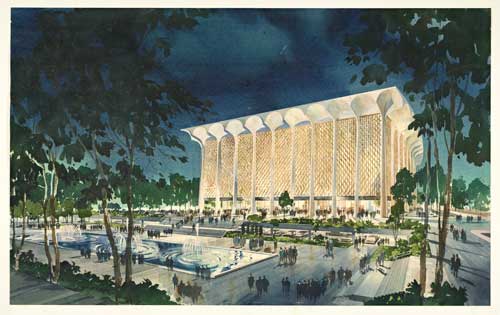OCTOBER 20, 2013–MARCH 10, 2014
“Every city has had its boom, but the history of Los Angeles … should be regarded as one continuous boom punctuated at intervals with major explosions.” —Carey McWilliams, Southern California: An Island on the Land, 1946

During the mid-20th century, Los Angeles rapidly evolved into one of the most influential industrial, economic, and creative capitals in the world. With its benign climate, diffuse development patterns, and car-oriented culture, L.A. attracted new residents with the promise of an informal, independent lifestyle. At the same time, the city was emerging as a hotbed of cutting-edge architecture, supported by ambitious patrons, innovations in building materials and technology, and bold investments in infrastructure.
Overdrive: L.A. Constructs the Future, 1940–1990 traces the city’s transformation into an internationally recognized destination with its own design vocabulary, canonized landmarks, and coveted way of life. Organized by the Getty Research Institute and the J. Paul Getty Museum, the exhibition features hundreds of original drawings, photographs, and models drawn from the collection of the Getty and dozens of other institutions. These artifacts offer new perspectives on familiar L.A. landmarks and reveal some fascinating, lesser-known works, while illuminating the critical factors that led to the city’s rise as a design mecca.
Overdrive refers to the extraordinary pace and global impact of L.A.’s impressive growth. The term also alludes to the fact that an engine churning at top speed may overheat. In the face of complicated civic, socioeconomic, and environmental challenges, L.A. has continuously recalibrated and adapted, frequently leading to bold new cycles of architectural exploration. This exhibition offers a rare, broad-based look at the development of one of the world’s most complex cities: ecologically precarious, often frustrating, and yet undeniably alluring.
The exhibition is divided into five major sections.
Car Culture

Los Angeles’s identity is inextricably linked to the automobile. After World War II, cars were transformed from convenient modes of personal transportation into gleaming symbols of self-expression. Increasingly imaginative—and sometimes outrageous—designs for cars inspired L.A. architects to create new kinds of structures geared toward motorized lifestyles. From drive-in churches to coffee shops designed to attract attention from drivers whizzing by at high speed, such car-oriented buildings shaped the city’s reputation as the capital of curbside culture.
Urban Networks
The daring expansion of L.A.’s water and power infrastructure, the aggressive implementation of its pioneering freeway plan, and the strategic development of its major transportation hubs all fueled the metropolis’s phenomenal growth. This section of the exhibition highlights the projects that were at the foundation of the region’s transformation into a global powerhouse, including the Hoover Dam (linked to the city by a 266-mile transmission line), and the channelization of the Los Angeles River.
Engines of Innovation
L.A.’s thriving industries gave designers access to innovative materials and fabrication technologies. Architects were challenged to design dynamic new building types, including cutting-edge aerospace headquarters and the world’s first television studio complex, CBS Television City. Emerging new-media clients inspired developers to transform unassuming warehouses into radically reconfigured work spaces designed by innovative architects such as Eric Owen Moss.
Community Magnets
Los Angeles used architecture to bolster its modern identity and promote social engagement through vibrant facilities dedicated to culture, sports, consumerism, and faith. Disneyland redefined amusement park design as well as worldwide popular culture. The Music Center, famed as the site of numerous awards shows, was L.A.’s answer to New York’s Lincoln Center and Washington’s Kennedy Center. The later Walt Disney Concert Hall, a seminal work by Frank Gehry, brought new energy to downtown.
Exhibition Publication
Overdrive: L.A. Constructs the Future, 1940-1990, edited by Wim de Wit and Christopher James Alexander

Related Content
L.A.: Land of (Unrealized) Possibilities: An Interview with Sam Lubell
Residential Fabric
More than any other building type, the private house has made Los Angeles famous for innovation in modern architecture. The ideal Southern California climate and varied natural terrain lured prospective homeowners to the West Coast, and provided architects with opportunities to rethink the configuration and aesthetics of the conventional dwelling. The famed Case Study House program, launched in 1945, resulted in a series of exemplary residences, while later, visionary architects such as John Lautner created some of the most striking houses ever built.

Co-organized by the Getty Research Institute and the J. Paul Getty Museum, Overdrive: L.A. Constructs the Future, 1940–1990 was part of the initiative Pacific Standard Time Presents: Modern Architecture in L.A., which celebrated Southern California’s lasting impact on modern architecture through exhibitions and programs organized by seventeen area cultural institutions from April through July 2013.
Overdrive: L.A. Constructs the Future, 1940–1990 is the winner of the 2013 Charles Redd Center for Western Studies Award for Exhibition Excellence.
Sponsors
Overdrive: L.A. Constructs the Future, 1940–1990 is generously supported by the Milton and Dorothy Sarnoff Raymond Foundation, ZGF Architects LLP, Lois England, and the Reinsch Pierce Family Foundation, Lola C. Reinsch and J. Almont Pierce.
